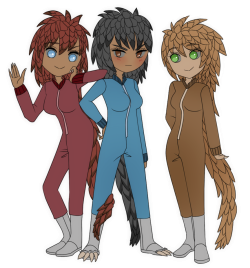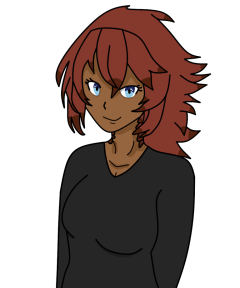Table of Contents
Kudhacari
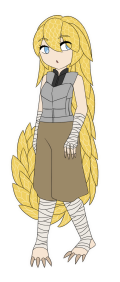 The Kudhacari are a subterranean spacefaring species that hails from the Eutherion system in the galactic northwest. Other than their home world, the species only occupies one other habitable planetoid in the system: a large terrestrial moon in orbit around Eutherion IV. Smaller colonies throughout the Kudhacari home system exist, but few maintain permanent trappings of civilization.
The Kudhacari are a subterranean spacefaring species that hails from the Eutherion system in the galactic northwest. Other than their home world, the species only occupies one other habitable planetoid in the system: a large terrestrial moon in orbit around Eutherion IV. Smaller colonies throughout the Kudhacari home system exist, but few maintain permanent trappings of civilization.
Species Overview
Large overland predators forced ancient Kudhacari to find refuge under the surface during their vulnerable sleeping hours. Today, they have no aversion for the surface but still build and habitate underground. They have a bred-in affinity for digging and clawed hands suited for the task, and find architecture built in harmony with the earth—chiseled and sculpted from existing matter—more beautiful than sweeping, skyward structures.
Because the female birthrate far outpaced the male birthrate long ago, Kudhacari are a non-monogamous people out of necessity. Though strong romantic bonds are the norm, most members of the species will have many reproductive partners who are usually from outside of their immediate family unit.
Physiology
A diminutive humanoid species, the Kudhacari are characterized by hard armored plates that flow from their heads, run down their backs, and end up wrapped between their legs to protect the species' lower torso. They are a generally hairless, mammalian species, though they do grow eyebrows and older males from certain tribes can grow facial hair on their chin and under their nose.
The species has broad, leathery, leaf-shaped ears protected by scale plates that hang over to obscure them from sight and hinders their ability to otherwise hear sounds at their full physical potential. Small tufts of fur protrude from under the outer ear fold to protect the inner from contaminants. Though some races of Kudhacari do not have the sound-dampening scales disabling their hearing—and some trim back those scales by choice—exposed ear flesh is considered unsightly in normal society.
With an average species-wide height of about 5 feet tall, Kudhacari are small, compact and sturdy creatures, though they can rage from 4' 4“ to 5' 2.” Because of their heavy, armor-like scales—as well as the skeletal and muscular systems to support their physique—the species has an average weight of approximately 130 lbs. and can range from around 110 to 160.
More specific physical traits, such as the color of their skin, scales, and eye patterns are dependent on their ancestral origins. There are seven notable nations of Kudhacari culture that make up their civilization.
Scales and Tail
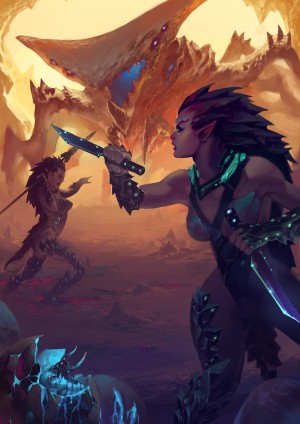 The most noticeable physical trait of the Kudhacari are the sharp scale plates that seemingly replace the hair found on heads of other beings. These are formed of a hard keratin that is soft at birth, but grows tougher as the Kudhacari grows. A fully mature specimen's scales form an armor-like protection strong enough to prevent sharp impacts and resilient enough to absorb intense heat exposure.1) The plates along the top of the head do tend to stay slightly more soft and pliant than the rest, but are still heavy structures that can protect a Kudhacari from their attacker.
The most noticeable physical trait of the Kudhacari are the sharp scale plates that seemingly replace the hair found on heads of other beings. These are formed of a hard keratin that is soft at birth, but grows tougher as the Kudhacari grows. A fully mature specimen's scales form an armor-like protection strong enough to prevent sharp impacts and resilient enough to absorb intense heat exposure.1) The plates along the top of the head do tend to stay slightly more soft and pliant than the rest, but are still heavy structures that can protect a Kudhacari from their attacker.
Some Kudhacari have darker, redder plate with sharper edges, while others are lighter and more blunt. Almost any scale color and skin combination can be found somewhere within the species. The plates will continue to grow very slowly throughout life as they harden and become heavier. Many older Kudhacari will to develop a hunched posture from dealing with the constant strain and ever-increasing weight.
Kudhacari scales can grow long and broad enough to wrap around through their legs with the tip reaching up to the navel, though a longer tail—which can reach as far as up to the nose—is a throwback to a more primitive form of the species. The condition of having scales that continue down one's arms towards the elbows and scales that cover the sides of one's thighs to the knee are similar evolutionary leftovers found in some Kudhacari.
Though their scaleform tails are prehensile, because of the nature of its anatomy, it has a rather limited range of movement and is only really good for curling around distinct objects.
Skeletal and Muscular System
Overall, Kudhacari tend to be stalwart creatures, with a musculature that supports carrying such a heavy weight day after day. They are a physically active species who enjoy a healthy, athletic lifestyle. The majority of their muscles are contracted when at rest, and Kudhacari curl up into a natural fetal position when asleep. The species' skeletons are similarly hearty: Their bones must be able to bear the weighty load of their scales.
Each hand on a Kudhacari supports four fingers and a thumb, having claw-like fingernails that were used by their ancestors for rending through soil. Similarly, their feet have five claw-like toenails.
Eyes
Eye color is largely dependent on the Kudhacari's ancestral nation, and almost any naturally occurring color is possible dependent on that. From brown and green and blue to golden yellows, oranges, greys and everything in between, very few colors are considered unknown. Kudhacari eyes are commonly dominated by blackness, though, as their retinal aperture is capable of extreme expansion to accommodate the dim underground dwellings they call home. They are able to see up to 100 meters as if an area were well-lit as long as there is some form of mior illumination nearby.2)
Eating and Diet
The Kudhacari are omnivorous humanoids that enjoy hearty, fatty meals despite their generally lithe physiology.
The species has long tongues that can reach out to around eight inches, while their sticky, gooey saliva has a high sugar content. These traits allow Kudhacari to eat simply by dipping their tongue into their meals and slurping it up into their mouths. As such, when a Kudhacari chooses to eat their meal this way it can be a noisy affair. Many—especially spacefaring individuals—believe eating in such a manner is extremely rude, provincial, or bumpkin-like.
A rare condition exists where the tongue is not solidly connected to the hyoid bone and sufferers have trouble speaking properly. Some Kudhacari cultures find this humorous, while others would be appalled at making fun of someone with such a condition.
Environment
Kudhacari are an Oxygen-breathing, carbon-based species that can live in a range of environments similar to most other humanoids. Although they prefer warmer temperatures and are protected by scales resilient to direct thermal radiation, they have no problems coping with the cold.
Reproduction
Kudhacari reproduce sexually, giving birth after a 6 month gestation. Single offspring are the most common, though twins and triplets account for about one-quarter of all births with 99 percent of twins and triplets being fraternal. For every 100 children born, only around 17 are male.
Females ovulate, on average, once every 22 days, and remain fertile throughout their lives. Likewise, males can reproduce at any point during their lifespan after adolescence. Still, old age often impairs Kudhacari from engaging in sexual intercourse.
| Life Phase | Years in AV 3) | Years in YE |
|---|---|---|
| Infancy | 0-2 | 0-2 |
| Childhood | 3-7 | 4-8 |
| Adolescence | 8-13 | 10-16 |
| Young Adult | 14-17 | 17-20 |
| Adulthood | 18-64 | 22-77 |
| Old Age | 65+ | 78+ |
Life Cycle
After about 65 years, Kudhacari begin to physically deteriorate and it is virtually unheard of for one to live past 80. Years of physical stress from carrying around an ever-heavier coat of scales takes its toll on the Kudhacari physique and, by life's end, they are unable to do much more than curl up and sleep. Any more exertion causes great pain and can prove disastrous; tendons can snap, bones will fracture and buckle, and the ability to even stand upright is an extreme feat.
To figure out your Kudhacari's age in proportion to Yamataian years use this formula: Take your Kudhacari's age, multiply it by 6 and then divide it by 5.
Society
As a people, the Kudhacari are a very social race. They live in large family units of 20 to 30 members, with cousins, aunts, and uncles living in the same domicile. As younger Kudhacari find mates via friends or the workplace, they will band together to build a new home for the new family unit. The closeness that Kudhacari treat one another with means that it is near impossible for outsiders to invade an area without being noticed. Their reliance on large family structures also extends to their feelings on communities on a larger scale. Kudhacari are very protective of those they feel close to, even on a species-wide level.
Government
The 11.3 billion living Kudhacari are governed by a unitary system called The Athatidesana Triumvirate. Three leaders—one each from the civil service, military service, and industrial guilds—share equal responsibility for major executive decisions.
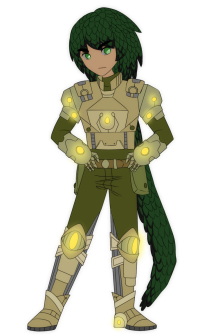
Spirituality
They do not worship any deities or adhere to any sort of organized religion. Still, the species does believe in the existence of spirits who live in harmony with the galaxy around them. Eutherion's surface, as well as the surface of any world, is considered the realm of the spirits, and that belief contributes to the practice of not disturbing natural landscapes and ecosystems without necessity.
Technology
The Kudhacari have an average level of technology for the SARPiverse. While most of the populace is unaware of the secrets of faster-than-light travel, scientists have made successful hyperspace forays into the nearby nebula. Most Kudhacari armaments are based on mining technology, such as microwave heat guns and massive drills affixed to the prows of their spacecraft. Additionally, due to the species' attention to personal protection, Kudhacari military forces favor the use of robotic drones during infantry engagements, which specialized soldiers “puppeteer” from front line power armor exoskeletal rigging.
Notable Kudhacari
OOC Notes
This page was originally created on 2012/11/05 00:04 by raz and Revolver. It was updated on 2016/09/28 00:15.
Faction Will
If Faction Manager raz becomes inactive for more than a year, the Kudhacari are not up for adoption. At their current state of development, assume that an FTL drive experiment wiped out all members of their species currently residing in the home system, effectively destroying the species and preventing it from future use. Extant player characters are permitted to continue being played, but may not be used to revive the species due to their complex and alien genetic code.
If raz returns, the faction will immediately revert to being under his control again, since he's the original creator. Any attempts at circumventing this will's requests shall result in raz signing in to claim management of his faction.
